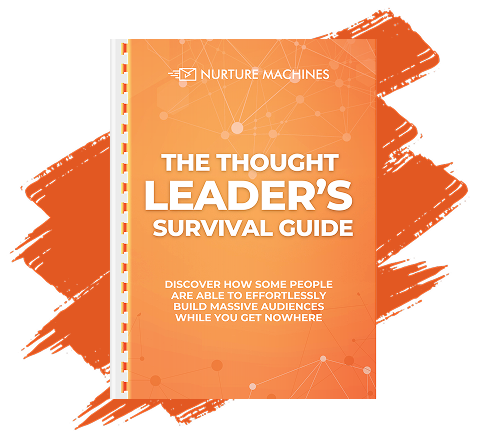Customer acquisition is evolving faster than ever, driven by shifting consumer behaviors, new technologies, and real-time performance data. To stay ahead, businesses must not only adapt their strategies but also adopt tools that make them agile and efficient. Nurture Machine empowers businesses to do exactly that by offering AI-powered personalization, omnichannel automation, and deep performance insights.
This blog explores how market trends shape acquisition tactics and how businesses can adapt with data-driven flexibility. From optimizing marketing channels to integrating cross-platform strategies, we break down the steps to succeed in dynamic environments. Whether you’re scaling or fine-tuning, staying responsive is key to sustainable growth.
Key Takeaways
- Customer acquisition strategies must evolve with digital trends and consumer behavior.
- Real-time analytics and predictive tools enable smarter, faster decision-making.
- Nurture Machine helps businesses personalize, segment, and automate across channels.
- Cross-channel integration and attribution boost acquisition efficiency and ROI.
- Agile frameworks and continuous performance tracking support long-term success.
What Are the Key Market Trends Affecting Customer Acquisition Today?

Businesses must adapt to evolving trends that reshape how customers discover and engage with brands. Digital transformation drives demand for seamless, personalized experiences across devices. Data analytics and predictive insights enable more precise targeting and campaign refinement. Social engagement and influencer partnerships expand acquisition channels beyond traditional ads. Meanwhile, competitive landscapes require agile advertising strategies that balance SEO, paid media, and optimized landing environments. Finally, retention tactics such as loyalty programs reinforce acquisition efforts by nurturing long-term relationships.
Which Emerging Consumer Behaviors Should Businesses Monitor?
Today’s consumers expect instant, personalized interactions and seamless digital journeys. Mobile usage dominates research and purchase behaviors, making responsive design essential. Audiences increasingly trust peer recommendations and social proof over direct advertising. Value-driven purchasing decisions emphasize transparency in pricing and brand ethics. Subscription models and loyalty programs remain popular for predictable benefits. Real-time feedback channels, such as live chat and social listening, inform rapid strategy adjustments. Businesses that track these behaviors can refine acquisition tactics to meet shifting expectations.
How Do Competitor Strategies Shift With Market Trends?
Competitors blend inbound and outbound tactics to stay ahead, combining high-quality content and SEO with targeted paid campaigns. Many leverage automation platforms and machine learning to adjust bids and creative in real time. Improved user experiences—via faster sites and intuitive interfaces—enhance conversion rates. Cross-channel consistency, from ads to emails, strengthens brand recall. Interactive approaches such as personalized journeys or real-time feedback loops differentiate offerings. Staying aware of these shifts allows businesses to benchmark performance and adopt similar agile tactics.
What Role Does Technology Play in Evolving Market Trends?
Advanced technologies underpin modern acquisition strategies, from AI-driven dashboards to predictive analytics that forecast campaign outcomes. Integration of marketing automation with CRM systems streamlines lead nurturing and follow-up. Mobile apps and responsive web platforms ensure accessibility at every touchpoint. Cloud-based solutions unify data from disparate channels for holistic insights. Innovations like chatbots and virtual assistants provide instant engagement and support. Overall, technology accelerates responsiveness to market changes and empowers more efficient, data-backed acquisition efforts.
How Can Businesses Adapt Their Customer Acquisition Strategies to Market Changes?

Adapting to market shifts requires flexibility, continuous monitoring, and data-driven decision-making. Real-time analysis of campaign performance helps detect early signs of change. Rapid resource reallocation ensures that high-performing channels receive proper investment. Collaborative workflows between teams improve alignment across all customer touchpoints. Testing different creative assets, formats, and platforms supports better responsiveness. Regular strategy reviews enable refinement and reduce the risk of outdated tactics. Agile methodologies ensure marketing can evolve alongside audience needs.
What Are Data-Driven Approaches to Strategy Adaptation?
Data-driven strategies begin with robust tracking of acquisition metrics and campaign outcomes. Analytics platforms identify performance trends and highlight which channels contribute most to conversions. Segmentation tools group users by behavior, allowing personalized messaging that increases engagement. A/B testing refines creative elements like visuals and CTAs to boost results. Real-time dashboards provide transparency and quick access to campaign data. Attribution models clarify what interactions drive results. Using these insights supports quick, accurate adjustments. These approaches reduce waste and improve overall efficiency.
How to Develop Flexible Acquisition Plans for Dynamic Markets?
Flexible acquisition plans start with detailed market research and clear KPIs. Establishing baselines for CAC, CTR, and conversion rates creates a reference point for adjustments. Resource allocation must remain fluid, shifting between platforms as audience behavior evolves. Contingency strategies help manage disruptions, such as unexpected cost increases. Agile frameworks allow for regular assessment and change, rather than rigid annual planning. Integrated analytics tools ensure decisions are grounded in real-time data. Collaborative planning between departments supports fast, unified responses.
Which Marketing Channels Should Be Optimized Based on Market Trends?

Marketing channels evolve as consumer preferences, technology, and platform features change. Businesses must continually assess where their audience is most active and which channels generate the best results. Optimization ensures that resources are directed toward strategies that align with current behavior. Data insights from dashboards help detect trends in traffic, conversions, and engagement. Ongoing refinement supports stronger performance and more efficient acquisition.
How to Leverage SEO and Content Marketing for Trend Adaptation?
SEO and content marketing must reflect updated search behavior and platform algorithms. This begins with detailed keyword research and competitor analysis. On-page SEO improvements, such as metadata optimization and semantic structure, boost visibility. High-value content—like tutorials, industry insights, and pillar articles—attracts qualified leads organically. Visual content, including infographics and videos, supports better engagement and shareability. Repurposing evergreen content into fresh formats extends its reach. Performance monitoring helps identify which topics convert best. Content calendars ensure relevance and consistency across channels.
What Is the Impact of Paid Advertising Shifts on Acquisition?
Paid advertising adapts quickly to consumer behaviors and platform changes. Automated bidding strategies now adjust in real time to optimize results. Dynamic creative testing allows brands to serve high-converting ads without delay. Personalization tools enable highly targeted messaging based on user behavior. Multi-platform campaigns unify search, display, and video to maximize reach. Budget reallocation becomes easier with real-time CPC and ROAS insights. Geo-targeting and device-specific ads improve engagement. Constant evaluation of ad formats ensures alignment with user expectations.
How Can Social Media Trends Influence Customer Acquisition Tactics?
Social media channels must reflect real-time shifts in user engagement patterns. Trends like short-form videos, live streams, and stories reshape content strategies. Engagement tools such as polls and Q&As boost interaction and visibility. Influencer partnerships amplify reach and improve trust among niche communities. Platform algorithms prioritize relevance, requiring consistent content updates. Paid promotions with behavioral targeting ensure messages reach high-intent users. Listening tools track sentiment and feedback for continuous refinement. Analytics reveal which formats and topics drive acquisition success.
How Do Performance Measurement and Analytics Drive Acquisition Success?

Performance measurement allows businesses to gauge what’s working and what needs adjustment. Analytics transform raw campaign data into actionable insights. When measured in real time, these metrics empower agile decision-making across all acquisition channels. Integrated dashboards consolidate touchpoint data to monitor trends and pinpoint issues early. Together, they form the backbone of a responsive, high-conversion acquisition strategy.
What Key Metrics Indicate Effective Adaptation to Market Trends?
Key metrics help assess how well acquisition strategies align with evolving market demands. Conversion rate growth suggests successful targeting and messaging adjustments. A declining customer acquisition cost indicates improved efficiency and smarter budget use. Return on ad spend provides clarity on campaign profitability. Customer lifetime value shows long-term impact, balancing acquisition with retention. Churn rate helps identify friction in post-conversion stages. Click-through and engagement rates signal content relevance and appeal. These metrics guide timely refinements across channels. Regular reviews ensure continued alignment with performance goals.
How to Use Dashboards for Real-Time Acquisition Insights?
Dashboards centralize key performance indicators from multiple marketing platforms. They provide instant visibility into metrics like CAC, CTR, CLTV, and ROI. Visual tools—like graphs and trend lines—make patterns easier to interpret. Real-time data allows marketers to act immediately on shifts in performance. Cross-channel visibility supports unified strategy adjustments. Predictive analytics tools alert teams to potential issues before they escalate. Dashboards also support collaboration by keeping all departments informed. This transparency enhances campaign agility and accelerates results.
What Are Best Practices for ROI Tracking in Customer Acquisition?
Effective ROI tracking starts with defining clear goals and KPIs before launching campaigns. Attribution models link revenue back to specific channels or touchpoints. Real-time tools monitor ROI fluctuations and detect underperformance early. Segmenting ROI reports by channel reveals which ones are cost-effective. Visual dashboards support fast analysis and informed reallocation. Regular A/B testing improves strategy precision and enhances returns. ROI reviews should guide both short-term tweaks and long-term planning. A clear understanding of ROI ensures marketing dollars are well spent.
What Are the Benefits of Multi-Channel Optimization in Changing Markets?

Multi-channel optimization ensures businesses engage customers wherever they are. By using a mix of platforms, brands create a seamless journey that boosts visibility. Each channel reinforces the others, improving conversion and retention. Real-time performance tracking helps adjust strategies quickly as behaviors shift. This adaptive approach increases marketing impact and strengthens acquisition results.
How Does Integrating Channels Improve Acquisition Efficiency?
Channel integration streamlines the customer journey and reduces messaging inconsistencies. When SEO, paid ads, email, and social content work together, user experience improves. A unified voice across platforms enhances trust and brand recall. Integrated data helps identify high-performing channels and moments of engagement. Real-time adjustments based on full-funnel insights become easier to execute. This synchronization reduces duplicated efforts and wasted spend. Personalized journeys can be built using cross-channel touchpoint data. Efficiency increases as each part of the funnel supports the next seamlessly.
What Challenges Arise in Multi-Channel Management?
Managing multiple channels presents challenges in alignment, resource allocation, and tracking. Inconsistent messaging across platforms can confuse prospects and weaken brand presence. Data fragmentation makes unified reporting difficult without advanced tools. Different teams managing separate channels may operate in silos. Shifts in one channel’s performance can disrupt the entire strategy if not detected early. Budgeting becomes complex when results vary widely between sources. Attribution modeling can be unclear without cross-platform visibility. System integration often requires technical setup and regular oversight. Addressing these pain points is key to maintaining performance.
How to Measure Cross-Channel Attribution Effectively?
Effective attribution tracks the value each channel brings to customer acquisition. Multi-touch models assign credit across all interactions, offering a fuller performance picture. Tools that integrate CRM and analytics simplify tracking across platforms. Dashboards highlight patterns in user behavior and journey progression. Comparing time-to-conversion across channels uncovers optimization opportunities. Attribution insights help rebalance budgets for stronger results. Consistent reporting processes ensure teams stay aligned on impact. Regular evaluations identify gaps in the buyer journey and guide refinements.
Frequently Asked Questions
How does Nurture Machine help businesses adjust to evolving customer acquisition trends?
Nurture Machine supports trend-based adaptation by providing omnichannel automation, real-time analytics, and AI-powered personalization. As consumer behaviors shift, businesses using Nurture Machine can track campaign performance across channels and optimize accordingly. Its behavioral targeting and segmentation tools allow brands to deliver relevant content in the moment, aligning perfectly with trends like mobile-first experiences and value-driven purchases.
What metrics does Nurture Machine track to improve acquisition strategy performance?
Nurture Machine tracks essential acquisition metrics such as Customer Acquisition Cost (CAC), Lifetime Value (LTV), click-through rates, and conversion rates across email, SMS, push notifications, and more. Its real-time dashboards simplify monitoring and enable teams to make fast, informed decisions. These metrics help businesses understand what’s working, where to allocate budgets, and how to scale campaigns based on clear performance indicators.
How does Nurture Machine enable smarter budget planning for acquisition campaigns?
Nurture Machine’s platform includes forecasting tools and campaign-level performance breakdowns, allowing businesses to allocate budget based on ROI. By integrating CRM data with engagement metrics, teams can evaluate channel-level impact and shift spend dynamically. Whether optimizing across paid ads, email, or SMS, Nurture Machine ensures acquisition dollars go to the most effective tactics, minimizing waste and boosting results.
In what ways does Nurture Machine support multi-channel optimization?
Nurture Machine unifies campaign delivery across email, SMS, push, and social messaging into a single platform. This integration improves customer journey consistency and simplifies performance tracking. With built-in cross-channel attribution and lifecycle automation, businesses can deliver timely, personalized messages at every stage. This not only enhances customer acquisition but also contributes to stronger retention.
How does Nurture Machine help businesses personalize acquisition at scale?
Using AI-powered personalization and real-time segmentation, Nurture Machine allows businesses to craft highly relevant acquisition campaigns tailored to user behavior and preferences. Its automation tools trigger customized messages based on site visits, email clicks, or purchase intent. This ensures each touchpoint feels unique, leading to higher engagement, stronger conversions, and improved overall acquisition efficiency.
Conclusion
In today’s fast-moving market, effective customer acquisition demands more than static plans—it requires ongoing adaptation and data-backed decisions. Nurture Machine helps businesses meet this challenge by simplifying performance tracking, unifying multi-channel campaigns, and automating personalized messaging. With these capabilities, companies can respond to market changes quickly and optimize every stage of the customer journey. Integrated insights and agile execution turn acquisition from a guessing game into a measurable growth engine. By embracing tools like Nurture Machine, businesses unlock the flexibility needed to scale. The future of acquisition belongs to those who adapt—and do so intelligently.






